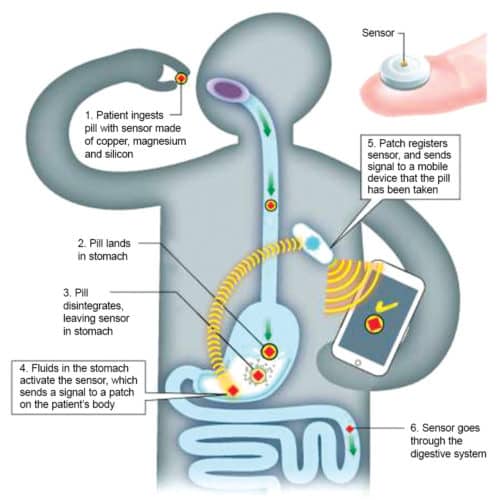Ubiquitous sensing with the use of passive sensors is on the rise - transforming work, healthcare, leisure and everyday life.
We would love to collect data relevant to our health without extra effort on our part. Carriable and wearable sensors require some effort - for example, they have to be periodically charged. They should be small, light and forgettable to be more convenient, but this increases the chance that you can forget or even lose them.
Ten years ago, wearables were predicted to evolve into insideables. The road was longer than expected. The rise and fall of Proteus Digital Health teaches us about the dangers of complexity and excessive costs in remote health. Besides inconveniencing the patients - that had to wear a patch to collect the signals from ingested pills - their technology also required commitment from insurers and doctors and changing the healthcare system's model of funding drugs.
But the ingestible sensors keep evolving. One of the latest proposals is a dissolvable biodegradable sensor that monitors gut bacteria.
Diagnosing and screening for digestive conditions is challenging and time-consuming. And so is monitoring and managing it. Assessment still heavily relies on self-report mechanisms and great opportunities exist for novel, transformational tools - but they should be sufficiently accurate, frequently updated and integrated with rapidly evolving knowledge, detailed, ethical, easy and fun to use (and maintain/calibrate), defending user privacy and developers' intellectual property while providing monetization opportunities.
Some sensors are more successful than others. Pfizer was able to monitor patients’ eczema-related scratching at night by providing them a wearable motion tracker. But there is a luck of fun tools for monitoring digestive disorders. The compliance to IBD-Home, for example, was very low (29%). Still, home monitoring was determined to be feasible and a fully digital Virtual IBD clinic is picking up steam.
REFERENCES
Inami A, Kan T, Onoe H. Ingestible Wireless Capsule Sensor Made from Edible Materials for Gut Bacteria Monitoring. In2022 IEEE 35th International Conference on Micro Electro Mechanical Systems Conference (MEMS) 2022 Jan 9 (pp. 110-113). IEEE.
Das SK, Miki AJ, Blanchard CM, Sazonov E, Gilhooly CH, Dey S, Wolk CB, Khoo CS, Hill JO, Shook RP. Perspective: opportunities and challenges of technology tools in dietary and activity assessment: bridging stakeholder viewpoints. Advances in Nutrition. 2022 Jan;13(1):1-5.
Puolanne AM, Kolho KL, Alfthan H, Färkkilä M. Is home monitoring of inflammatory bowel disease feasible? A randomized controlled study. Scandinavian Journal of Gastroenterology. 2019 Jul 3;54(7):849-54.
Taylor NS. Utilising new technologies and supported self-management to enhance the inflammatory bowel disease patient pathway: pilot, feasibility and development studies (Doctoral dissertation, University of Southampton).

